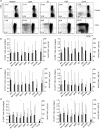T-cell response to viral antigens in adults and children with common variable immunodeficiency and specific antibody deficiency
- PMID: 20408855
- PMCID: PMC2940155
- DOI: 10.1111/j.1365-2249.2010.04159.x
T-cell response to viral antigens in adults and children with common variable immunodeficiency and specific antibody deficiency
Abstract
Several T cell abnormalities have been described in common variable immunodeficiency (CVID), a B cell disorder of mainly unknown origin. A subset of CVID patients suffers from frequent reactivations of herpes viruses. We studied T cell function in CVID [and in a subset of paediatric patients with specific antibody deficiency (SAD)] by measuring T cell proliferation and cytokine production in response to herpes virus-antigens in paediatric CVID patients (n=9) and paediatric SAD patients (n=5), in adult CVID patients (n=14) and in healthy controls. Paediatric CVID patients, but not SAD patients, displayed moderately increased CD8+ T cell proliferation in response to cytomegalovirus, human herpes virus type 6B (HHV6-B) and herpes simplex virus compared to controls. CD8+ T cell responses in adult CVID patients tended to be increased in response to cytomegalovirus and herpes simplex virus. In response to stimulation with herpes virus antigens, the proinflammatory cytokines interleukin (IL)-1beta, IL-6, tumour necrosis factor (TNF)-alpha and interferon inducible protein (IP)-10 were produced. Overall, no major differences were detected in cytokine production upon stimulation between patients and controls, although higher IL-10 and IL-12 production was detected in paediatric patients. In conclusion, cellular immunity against herpes virus antigens appears undisturbed in CVID patients, although defects in subpopulations of CVID patients cannot be excluded.
Figures


References
-
- Conley ME, Notarangelo LD, Etzioni A. Diagnostic criteria for primary immunodeficiencies. Clin Immunol. 1999;93:190–7. - PubMed
-
- Notarangelo LD, Casanova JL, Conley ME, et al. Primary immunodeficiency diseases: an update from the international Union of Immunological Societies Primary Immunodeficiency Diseases Classification Committee Meeting in Budapest, 2005. J Allergy Clin Immunol. 2006;117:883–96. - PubMed
-
- Goldacker S, Warnatz K. Tackling the heterogeneity of CVID. Curr Opin Allergy Clin Immunol. 2005;5:504–9. - PubMed
-
- van Zelm M. Antibody deficiency and acute nefritis syndrome in a patient with homozygous dysruption of the CD81 gene. Oral presentation at the 13th Meeting of the European Society for Immunodeficiencies, November 2008, Den Bosch, the Netherlands.
Publication types
MeSH terms
Substances
LinkOut - more resources
Full Text Sources
Research Materials

